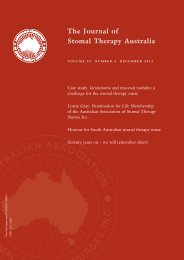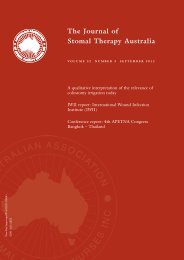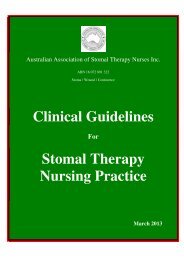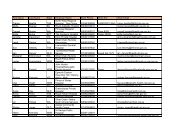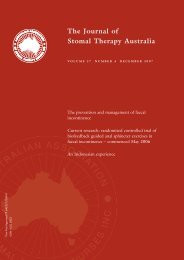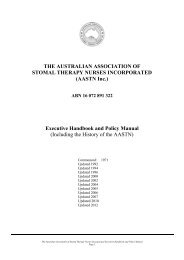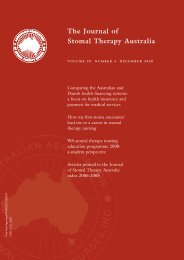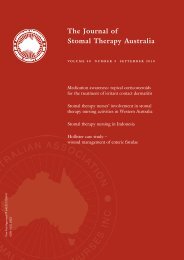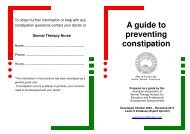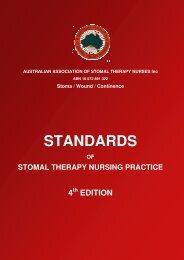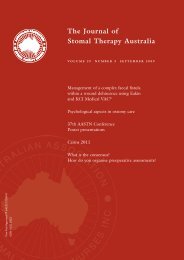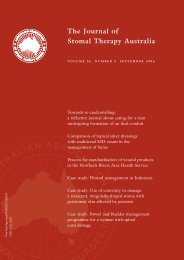The Journal of Stomal Therapy Australia - Australian Association of ...
The Journal of Stomal Therapy Australia - Australian Association of ...
The Journal of Stomal Therapy Australia - Australian Association of ...
Create successful ePaper yourself
Turn your PDF publications into a flip-book with our unique Google optimized e-Paper software.
poor construction <strong>of</strong> the stoma patients were unable to remain<br />
independent with their stoma care, discharge was delayed<br />
and costs increased in outlay for additional ostomy products.<br />
Importantly, ostomates who were sited pre-operatively had no<br />
problems with their stoma site.<br />
On completion <strong>of</strong> the third audit the results <strong>of</strong> the study were<br />
summarised and presented to the RHH Division <strong>of</strong> Surgery<br />
medical staff. Mr Oakley commented on the surgical problems<br />
that he recognised and gave advice.<br />
Mr Oakley also advised consultant surgeons and surgical registrars<br />
that all patients admitted for emergency bowel surgery should be<br />
sited for possible stoma formation. <strong>The</strong> siting should be done in<br />
preference by an STN or, in the absence <strong>of</strong> an STN, an otherwise<br />
experienced nurse; surgeons should site their own patients preanaesthetic<br />
and, if necessary, on the operating table 14 .<br />
<strong>The</strong> audit process demonstrated what was acceptable in terms<br />
<strong>of</strong> patient outcomes and unacceptable major risks <strong>of</strong> poorly<br />
sited or constructed stomas with consequential adverse effects<br />
on patient rehabilitation.<br />
Treat Risks<br />
At the time <strong>of</strong> the stoma audit, stoma construction did improve<br />
and siting was remembered. However, in the absence <strong>of</strong> ongoing<br />
attention to the problem, standards relapsed and the likelihood<br />
<strong>of</strong> an unsited, poorly constructed stoma again became an issue.<br />
In fully adopting the clinical risk management process STNs<br />
need to develop and implement specific, cost-effective strategies<br />
and action plans for increasing potential benefits and reducing<br />
potential costs 15 .<br />
Like any nurse, STNs are familiar with the nursing process, using<br />
assessment, planning, implementation and evaluation to organise<br />
patient care. <strong>The</strong> same process works well to treat risks, along with<br />
analysis and evaluation to identify and treat residual risk 1 . A good<br />
example <strong>of</strong> evaluation and identification <strong>of</strong> residual risk is the<br />
Audit Nursing Risk Assessment Tool developed by the Pressure<br />
Ulcer Prevention Project Officer at the Austin Hospital, Victoria.<br />
<strong>The</strong> aim <strong>of</strong> this audit was to review the usage <strong>of</strong> the Austin<br />
Health nursing risk assessment tool, a form used on each ward<br />
to evaluate pressure ulcer prevention. <strong>The</strong> information collected<br />
was used to assist in evaluating the effectiveness, utilisation and<br />
clinical appropriateness <strong>of</strong> the form 16 .<br />
Simply using the post-operative stoma photography audit with<br />
peer review has insufficiently addressed the risk that patients<br />
will progress to theatre without siting. Controlling risk is better<br />
addressed by developing and implementing policies, standards,<br />
procedures and making physical changes. If STNs do not have<br />
the organisational authority or power to bring about change<br />
from within their practice, it is recommended that there is a<br />
shift <strong>of</strong> responsibility to another party or higher authority 1 ,<br />
using the chain <strong>of</strong> command to bring about warranted and<br />
effective change. Listing suggested changes to ensure the siting<br />
procedure was performed would include:<br />
• A stomal therapy orientation package given to all new staff<br />
joining the general surgical team – doctors, nurses, allied<br />
healthcare pr<strong>of</strong>essionals.<br />
• All medical staff participating in basic surgical training<br />
– registrars, residents, interns attend a mandatory lecture on<br />
the necessity <strong>of</strong> siting. This practice to be sanctioned by the<br />
Medical Director – Division <strong>of</strong> Surgery.<br />
• STN education program be advocated at every possible<br />
opportunity to ensure the availability <strong>of</strong> suitably qualified<br />
staff to provide a service after hours and at weekends, and<br />
that their availability be widely advertised amongst nursing<br />
and medical staff.<br />
• That pre-operative siting be added to the operating theatre<br />
checklist and an audit conducted on compliance with the<br />
checklist.<br />
• Risk management policy and procedure document be written<br />
for the AASTN Education and Pr<strong>of</strong>essional Sub-committee<br />
to approve and post on the AASTN website.<br />
Once further controls have been instigated the pictorial audit<br />
can be repeated to re-evaluate risk stabilisation.<br />
CONCLUSION<br />
<strong>The</strong> intention <strong>of</strong> this paper is to promote risk management<br />
as a meaningful adjunct to quality improvement and realise<br />
positive outcomes for patients following ostomy surgery. Using<br />
the example <strong>of</strong> pre-operative siting demonstrates the need to<br />
constantly evaluate and re-evaluate procedures, and to measure<br />
and justify the effectiveness <strong>of</strong> our stomal therapy practice.<br />
REFERENCES<br />
1. Risk Management Guidelines – Companion to AS/NZS 4360:2004<br />
(Handbook). Standards <strong>Australia</strong>/Standards New Zealand.<br />
Wellington New Zealand. 2004:17.<br />
2. ibid, Risk Management Guidelines:VII.<br />
3. Desk Top Guide to Clinical Risk Management – Toolkit for Managing<br />
Risk in Health Care. Dept <strong>of</strong> Health Western <strong>Australia</strong>. 2005:3.<br />
4. <strong>Australia</strong>n Nursing Federation (ANF). Revised Competency<br />
Standards for the Advanced Registered Nurse. Draft, undated:1.<br />
5. <strong>Australia</strong>n <strong>Association</strong> <strong>of</strong> <strong>Stomal</strong> <strong>The</strong>rapy Nurses Inc (AASTN).<br />
Standards <strong>of</strong> <strong>Stomal</strong> <strong>The</strong>rapy Practice. Draft, 2005:3.<br />
6. ibid, AASTN:7.<br />
7. op cit, Risk Management Guidelines:13.<br />
8. Blackley P. Practical Stoma Wound and Continence Management.<br />
Victoria:Research Publications Pty Ltd. 1998:1.<br />
9. Health Risk Management – Policy and Framework. Western <strong>Australia</strong><br />
Public Health System. Feb 2005:3<br />
10. op cit, Desk Top Guide:8.<br />
11. op cit, Blackley:108.<br />
12. op cit, Blackley:112.<br />
13. op cit, Desk Top Guide:11.<br />
14. Hicks S. A Site to be Seen – Striving for Excellence. <strong>The</strong> <strong>Journal</strong> <strong>of</strong><br />
<strong>Stomal</strong> <strong>The</strong>rapy <strong>Australia</strong>, Sept 2002; 22(3):18.<br />
15. op cit, Desk Top Guide:17.<br />
16. Allen A. Audit Nursing Risk Assessment Tool, M15.21. Austin<br />
Health , Victoria. September 2005.<br />
20 JOURNAL OF STOMAL THERAPY AUSTRALIA 2007 27(3)



